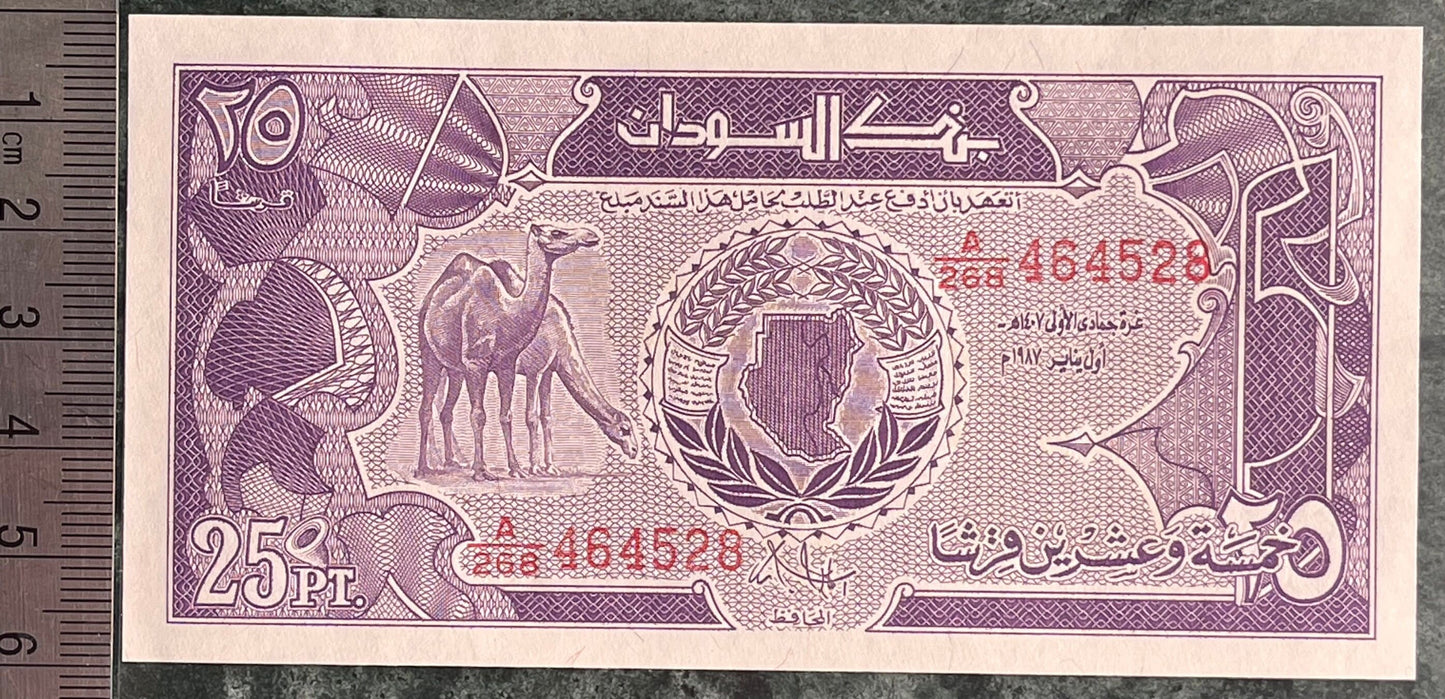elemintalshop
Dromedary Camels, Sudan Map & Central Bank 25 Piastres Authentic Banknote Money for Jewelry and Collage (Arabian)
Dromedary Camels, Sudan Map & Central Bank 25 Piastres Authentic Banknote Money for Jewelry and Collage (Arabian)
Couldn't load pickup availability
Dromedary Camels, Sudan Map & Central Bank 25 Piastres Authentic Banknote Money for Jewelry and Collage (Arabian)
Obverse: Dromedary Camels and outline map of Sudan
Lettering: Signature title in 1 line of Arabic text (Governor)
Reverse: Central Bank of Sudan building
Lettering: Bank of Sudan
Twenty Five Piastres
Watermark: Coat of Arms
Features
Issuer Sudan
Period Republic (1985-date)
Type Standard banknote
Year 1987
Value 25 Piastres (0.25 SDP)
Currency First pound (1956-1992)
Composition Paper
Size 121 × 60 mm
Shape Rectangular
Demonetized Yes
Number N# 210659
References P# 37
Wikipedia:
The dromedary (Camelus dromedarius) (/ˈdrɒmədɛri/ or /-ədri/), also known as Arabian camel,[2] is a large even-toed ungulate, of the genus Camelus, with one hump on its back.
It is the tallest of the three species of camel; adult males stand 1.8–2 m (5 ft 11 in–6 ft 7 in) at the shoulder, while females are 1.7–1.9 m (5 ft 7 in–6 ft 3 in) tall. Males typically weigh between 400 and 600 kg (880 and 1,320 lb), and females weigh between 300 and 540 kg (660 and 1,190 lb).
The species' distinctive features include its long, curved neck, narrow chest, a single hump (compared with two on the Bactrian camel and wild Bactrian camel), and long hairs on the throat, shoulders and hump. The coat is generally a shade of brown. The hump, 20 cm (7+7⁄8 in) tall or more, is made of fat bound together by fibrous tissue.
Dromedaries are mainly active during daylight hours. They form herds of about 20 individuals, which are led by a dominant male. They feed on foliage and desert vegetation; several adaptations, such as the ability to tolerate losing more than 30% of its total water content, allow it to thrive in its desert habitat. Mating occurs annually and peaks in the rainy season; females bear a single calf after a gestation of 15 months.
The dromedary has not occurred naturally in the wild for nearly 2,000 years. It was probably first domesticated in the Arabian Peninsula about 4,000 years ago, or in Somaliland where there are paintings in Laas Geel that figure it from more than 5,000 to 9,000 years ago. In the wild, the dromedary inhabited arid regions, including the Sahara Desert. The domesticated dromedary is generally found in the semi-arid to arid regions of the Old World, mainly in Africa and the Arabian Peninsula, and a significant feral population occurs in Australia. Products of the dromedary, including its meat and milk, support several north Arabian tribes; it is also commonly used for riding and as a beast of burden.
Wikipedia:
The Central Bank of Sudan is the central bank of Sudan. The bank was formed in 1960, four years after Sudan's independence. It is located in the capital Khartoum.
History
When Sudan achieved independence in 1956, the creation of a central bank was a priority. A 3-man commission of experts from the United States's Federal Reserve, worked with Sudanese government and finance specialists to create the Law of the Bank of Sudan for 1959, and in 1960 the Bank of Sudan began operations. To establish the bank, the Sudanese government nationalized the National Bank of Egypt's operations in the Sudan (some seven branches), and combined them with the Sudanese currency board.
In addition to the normal duties of a central bank, which may include minting coins and issuing banknotes, managing a country's internal and external accounting, and setting monetary policy and interest rates, Sudan's central bank is also responsible for fostering Islamic banking.
After Sudan introduced Islamic law (Sharia) in 1984, the banking and financial industry changed its practices to conform with Sharia. In 1993 the government established the Sharia High Supervisory Board (SHSB) to ensure compatibility of financial practices with Islamic principles. In compliance with the SHSB, the government is no longer selling treasury bills and government bonds; instead, the Bank sells "Financial Certificates" that comply with Islamic financial principles.
Wikipedia:
The emblem shows a secretary bird bearing a shield from the time of Muhammad Ahmad, the self-proclaimed Mahdi who briefly ruled Sudan in the 19th century.
Two scrolls are placed on the arms; the upper one displays the national motto, An-nasr lanā النصر لنا ("Victory is ours"), and the lower one displays the title of the state, جمهورية السودان Jumhūriyat as-Sūdān ("Republic of the Sudan").
The coat of arms is also the Presidential seal and is found in gold on the flag of the President of Sudan and on the vehicles carrying the President and at his residence.
The secretary bird was chosen as a distinctively Sudanese and indigenous variant of the "Eagle of Saladin" and "Hawk of Quraish" seen in the emblems of some Arab states, and associated with Arab nationalism (see Coat of arms of Egypt, etc.).
Share



















